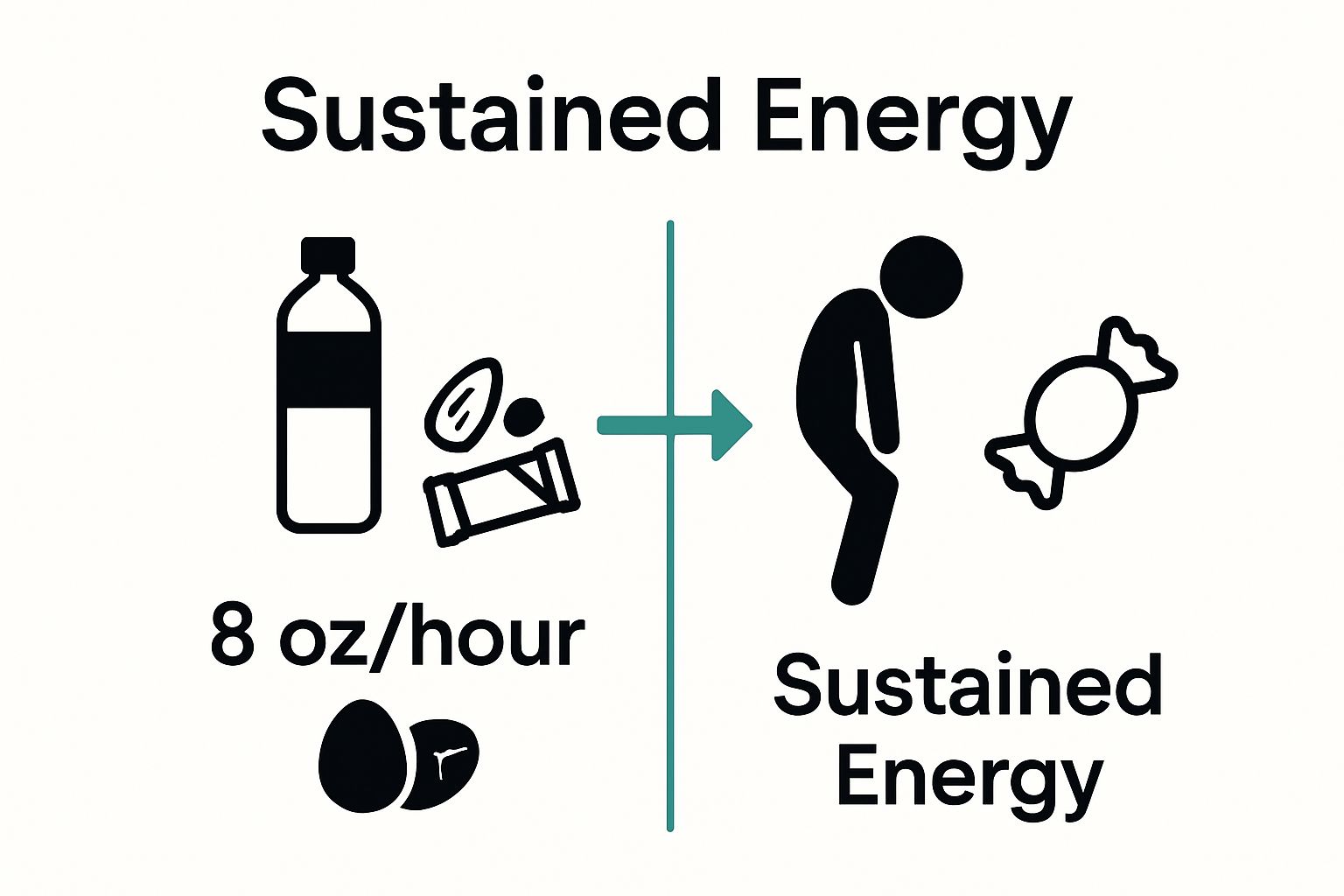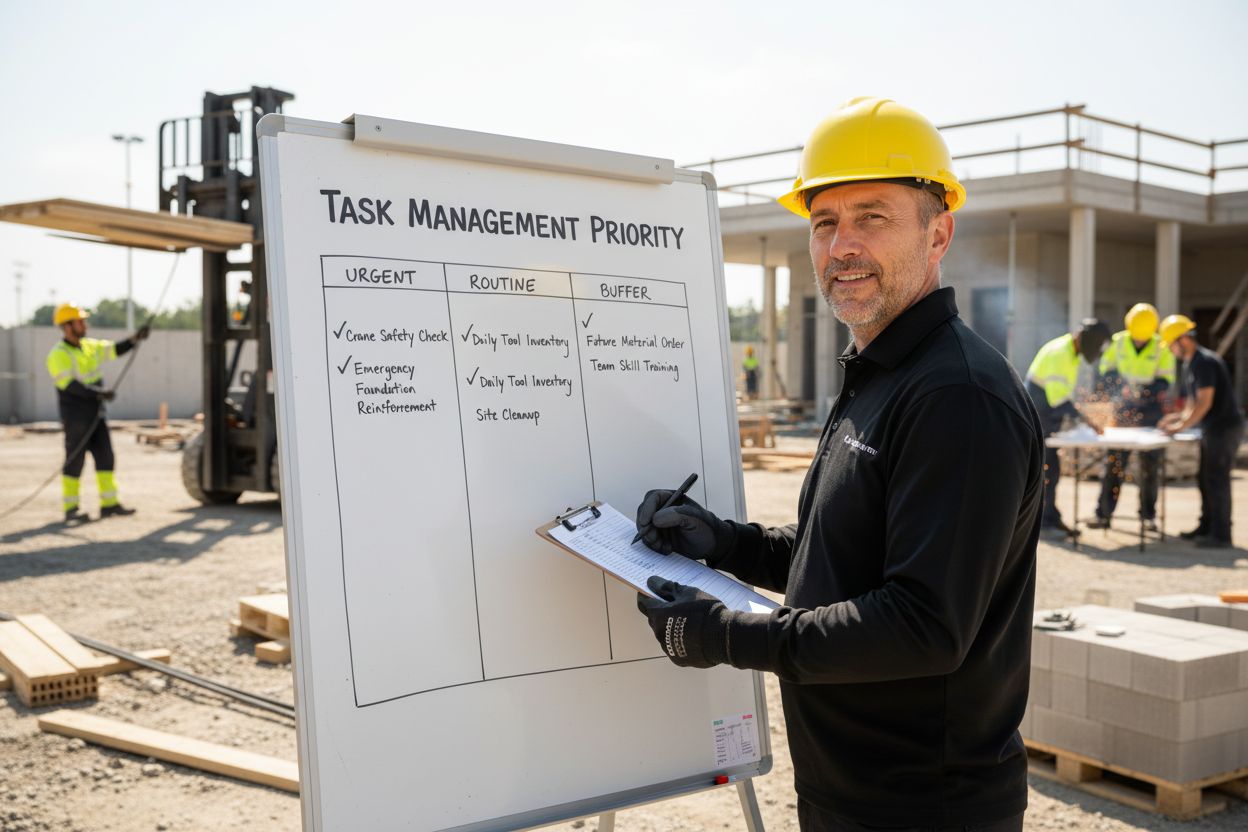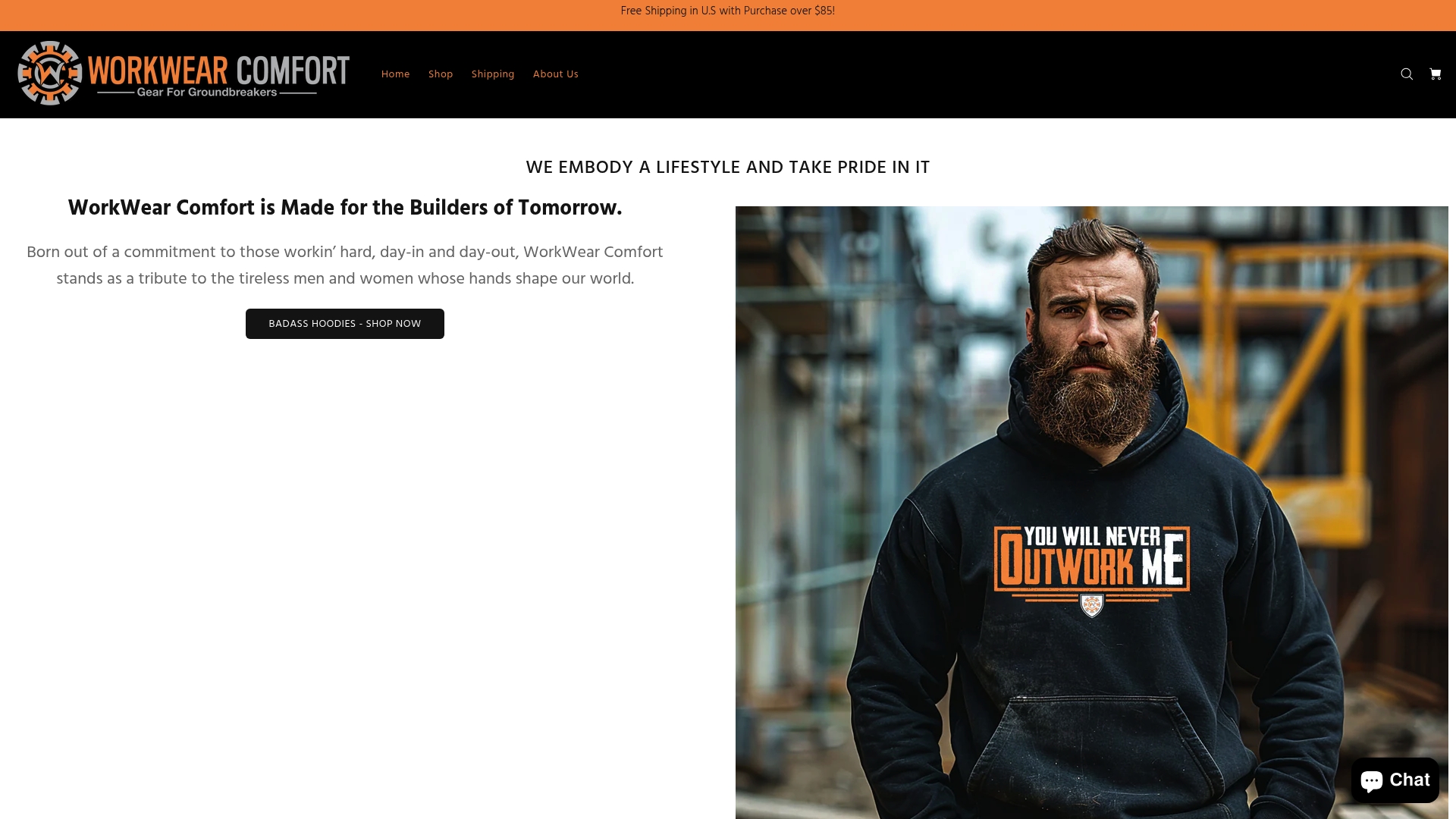Workplace fatigue can sneak up on anyone, turning a productive day into a struggle of heavy eyes and muddled thoughts. Shockingly, up to 65 percent of workers report feeling tired during the workday according to recent studies. While most people blame their sleep or workload, the real fix often starts right at your desk with small changes that can make a huge difference.
Table of Contents
- Step 1: Assess Your Work Environment For Comfort
- Step 2: Implement Regular Breaks And Stretching
- Step 3: Hydrate And Snack Wisely Throughout The Day
- Step 4: Organize Tasks For Efficient Workflow
- Step 5: Establish A Consistent Sleep Routine
- Step 6: Evaluate And Adjust Your Performance
Quick Summary
| Key Point | Explanation |
|---|---|
| 1. Optimize your workspace layout. | Evaluate your workstation for ergonomic issues affecting comfort and productivity to reduce fatigue. |
| 2. Schedule regular breaks and stretching. | Implement structured breaks every 60-90 minutes to refresh your body and mind, preventing fatigue. |
| 3. Maintain hydration and nutrition. | Drink water consistently and choose nutrient-dense snacks to support sustained energy throughout your workday. |
| 4. Organize tasks for better efficiency. | Prioritize and break down tasks into manageable segments to reduce overwhelm and improve focus. |
| 5. Establish a consistent sleep routine. | Create a sleep schedule that promotes recovery and aligns with your personal energy needs for optimal performance. |
Step 1: Assess Your Work Environment for Comfort
Reducing fatigue at work starts with creating an environment that supports your physical and mental well-being. Your workspace plays a critical role in determining your energy levels and overall productivity. Identifying and addressing potential comfort barriers can significantly minimize workplace exhaustion before it becomes a persistent problem.
Begin by conducting a comprehensive evaluation of your immediate work area. Look critically at your workstation setup, paying special attention to ergonomic factors that might contribute to physical strain. Workplace ergonomics research suggests that improper positioning can dramatically increase worker fatigue. Your chair height, desk configuration, computer monitor placement, and lighting all contribute to your potential energy drain.
Detailed Workspace Assessment Checklist:
- Is your chair supporting your lower back properly?
- Are your feet flat on the floor or supported by a footrest?
- Does your computer screen sit at eye level to prevent neck strain?
- Is your workspace adequately illuminated without causing eye strain?
Beyond physical setup, consider the environmental factors surrounding your work area. Temperature, noise levels, and air quality can subtly yet significantly impact your energy reserves. A workspace that feels too warm, has distracting background noise, or lacks proper ventilation can quickly drain your mental and physical resources. Check if your workspace promotes good air circulation, maintains a comfortable temperature between 68 and 76 degrees Fahrenheit, and minimizes unnecessary auditory distractions.
If you work in a physically demanding trade or outdoor environment, consider our guide on selecting workwear for challenging conditions to help manage environmental stressors.
Proper clothing and personal protective equipment can reduce physical strain and help maintain your energy levels throughout demanding workdays.
Successful workspace optimization requires ongoing attention. Regularly reassess your environment, making incremental adjustments as needed. Small changes like repositioning your monitor, using an ergonomic chair cushion, or introducing a desk fan can make substantial differences in your daily comfort and energy levels.
Here is a quick reference checklist to help you assess your workspace comfort and identify key areas for improvement.
| Assessment Item | What to Look For | Why It Matters |
|---|---|---|
| Chair Support | Lower back supported properly | Reduces back pain and fatigue |
| Foot Position | Feet flat on floor or on a footrest | Ensures circulation and posture |
| Monitor Placement | Screen at eye level | Prevents neck and eye strain |
| Lighting | Adequate but not harsh illumination | Reduces eye fatigue and headaches |
| Temperature | Comfortable, ideally 68-76°F | Prevents drowsiness or discomfort |
| Noise Level | Minimal background noise | Supports focus and mental energy |
| Air Quality | Good circulation and ventilation | Boosts alertness and wellbeing |
Step 2: Implement Regular Breaks and Stretching
Breaks are not a luxury but a critical strategy for maintaining energy and preventing workplace fatigue. Your body and mind require deliberate moments of rest and reset to perform at optimal levels. Physical activity research confirms that strategic breaks can significantly reduce exhaustion and improve overall cognitive function.
Establish a structured break routine that interrupts prolonged periods of static work. For those in physically demanding trades or sedentary roles, movement becomes essential. Aim to interrupt your work rhythm every 60 to 90 minutes with a purposeful break lasting 5 to 10 minutes. During these intervals, focus on gentle stretching and physical movement that counteracts your typical work posture.
Strategic Break Activities:
- Neck and shoulder rolls to release tension
- Standing back extensions to realign spine
- Wrist and ankle circular movements
- Deep breathing exercises
- Short walking intervals
Design your breaks to be intentional and efficient. Workers in construction, trades, and manual labor can adapt these principles by incorporating micro-breaks during task transitions. If you’re operating heavy machinery, climbing scaffolding, or performing repetitive physical labor, these brief moments of movement can prevent muscle stiffness and mental fatigue.
For desk-based workers and those in more sedentary roles, consider using technology to support your break strategy. Set timed reminders on your smartphone or computer that prompt you to stand, stretch, or walk around. Some productivity apps offer break tracking and guided stretching routines specifically designed for workplace environments.
Physical movement during breaks should not feel like another task but a rejuvenating reset. Listen to your body and recognize early signs of muscle tension or mental fog. If you find yourself struggling to maintain focus or experiencing physical discomfort, it’s time for a break. Check out our workwear guide for comfort tips that can help you stay comfortable during both work and break times.
Remember that consistency is key. Breaks are most effective when integrated regularly into your work routine. Track your progress by monitoring your energy levels, noting improvements in focus, and observing reduced physical strain throughout your workday.
Step 3: Hydrate and Snack Wisely Throughout the Day
Sustaining energy levels requires more than just willpower. Your body needs consistent nutrition and hydration to combat workplace fatigue effectively. Nutrition experts at Harvard emphasize the critical role of strategic eating and drinking in maintaining peak performance throughout demanding workdays.
Hydration is your first line of defense against energy depletion. Blue-collar workers and professionals in physically demanding trades lose significant water through sweat and intense physical activity. Establish a systematic approach to drinking water that goes beyond simply responding to thirst. Aim to consume approximately 8 ounces of water every hour, adjusting for your specific work environment and physical exertion levels.
Smart Hydration and Snacking Strategies:
- Carry a large, refillable water bottle marked with hourly consumption goals
- Choose nutrient-dense snacks that provide sustained energy
- Avoid sugary drinks and processed foods that cause energy crashes
- Prepare portable, protein-rich snacks in advance
Nutrition plays an equally crucial role in maintaining workplace energy.
 Select snacks that provide steady, slow-release energy rather than quick sugar spikes. Protein-rich options like nuts, hard-boiled eggs, or lean jerky can help stabilize blood sugar and prevent mid-afternoon energy crashes. For workers in physically demanding roles, these nutritional choices become even more critical in maintaining stamina and focus.
Select snacks that provide steady, slow-release energy rather than quick sugar spikes. Protein-rich options like nuts, hard-boiled eggs, or lean jerky can help stabilize blood sugar and prevent mid-afternoon energy crashes. For workers in physically demanding roles, these nutritional choices become even more critical in maintaining stamina and focus.
Consider your work environment when planning your nutrition strategy. Construction workers, mechanics, and outdoor laborers require different nutritional approaches compared to office-based professionals. Portable, non-perishable snacks that can withstand challenging work conditions are essential. Vacuum-sealed protein packs, trail mix, and compact protein bars can provide quick, reliable energy without requiring refrigeration or extensive preparation.
Check out our workwear guide for comfort tips that can help you manage nutrition and hydration in various work environments. Successful energy management is about creating sustainable habits that support your body’s natural rhythms and work demands.
Verify your hydration and nutrition strategy’s effectiveness by monitoring your energy levels, noting improvements in focus and physical performance. Adjust your approach based on your body’s responses, recognizing that individual nutritional needs vary across different professions and personal metabolisms.
Step 4: Organize Tasks for Efficient Workflow
Managing your workday effectively is crucial in reducing fatigue and maintaining consistent energy levels. Task organization transforms overwhelming workloads into manageable, strategic action plans. Psychological research confirms that structured task management significantly reduces stress and mental exhaustion.
Start by implementing a prioritization system that categorizes tasks based on urgency and importance. For blue-collar workers and trade professionals, this means evaluating daily responsibilities through a strategic lens. Break down complex projects into smaller, actionable segments that can be completed systematically. This approach prevents mental overwhelm and creates a sense of continuous progress throughout your workday.
Task Management Priority Checklist:
- Identify high-impact tasks that directly contribute to project completion
- Estimate realistic time requirements for each task
- Group similar tasks to minimize mental transition costs
- Create buffer time for unexpected challenges
- Review and adjust priorities at the start of each day
Utilize digital or analog tools that match your work style and environment. Construction workers might prefer physical notebooks or whiteboards, while office-based professionals might leverage smartphone apps or digital task management platforms. The key is selecting a system you will consistently use and that adapts to your professional demands.

Time blocking represents another powerful strategy for managing workplace energy. Allocate specific time windows for different types of tasks, creating predictable rhythms that reduce decision fatigue. For physically demanding roles, this might mean scheduling more complex tasks during peak morning energy periods and routine tasks during afternoon hours when mental stamina naturally declines.
Our workwear guide offers additional insights into optimizing workplace performance across various professional environments. Recognize that task organization is not about perfection but creating a flexible framework that supports your unique work rhythm.
Verify your task management strategy’s effectiveness by tracking completion rates, monitoring stress levels, and observing improvements in daily productivity. Be willing to experiment and adjust your approach, understanding that efficient workflow is a personalized journey of continuous improvement.
Step 5: Establish a Consistent Sleep Routine
Quality sleep is the foundation of workplace energy and performance, especially for professionals in physically demanding trades and high-stress occupations. Your body requires consistent, restorative rest to repair muscle tissue, process mental experiences, and recharge for the next day’s challenges. Sleep researchers emphasize that sleep is not a passive state but an active recovery process critical for maintaining optimal physical and mental performance.
Designing a sleep routine requires understanding your unique work demands and personal physiology. Shift workers, construction professionals, and trades workers often face irregular schedules that complicate consistent sleep patterns. Prioritize creating a sleep environment that supports rapid recovery and deep rest, regardless of your work schedule.
Critical Sleep Optimization Strategies:
- Maintain a consistent bedtime within 30 minutes of your target
- Create a dark, quiet sleeping environment
- Limit screen time at least one hour before bed
- Use white noise or earplugs to block disruptive sounds
- Invest in a supportive mattress and comfortable bedding
Prepare your body for sleep by establishing a deliberate wind-down routine. This might involve gentle stretching, reading, meditation, or light breathing exercises that signal to your body that it’s time to transition from work mode to recovery mode. For workers with physically demanding jobs, this preparation becomes even more crucial in helping muscles relax and mental stress dissipate.
Recognize that sleep quality matters more than pure quantity. While the standard recommendation is 7-9 hours, individual needs vary. Pay attention to how you feel upon waking. Are you refreshed and ready to tackle the day, or do you feel sluggish and unrested? Adjust your sleep environment and routine based on these personal insights.
Our workwear guide offers additional tips for managing physical recovery and workplace comfort. Consider your sleeping attire, bedroom temperature, and pre-sleep rituals as integral components of your overall energy management strategy.
Verify your sleep routine’s effectiveness by tracking your morning energy levels, workplace productivity, and physical recovery. Be patient and consistent, understanding that establishing an optimal sleep pattern takes time and personal experimentation.
Step 6: Evaluate and Adjust Your Performance
Continuous self-improvement is the cornerstone of managing workplace fatigue and maintaining peak performance. Professionals across trades and industries must develop a systematic approach to evaluating their energy management strategies. Harvard Medical School research highlights the critical importance of ongoing self-assessment in preventing burnout and optimizing personal productivity.
Establish a weekly self-review process that goes beyond simply tracking work completed. Create a comprehensive assessment that examines your physical energy, mental clarity, and overall workplace performance. This isn’t about criticism but about understanding your body’s unique rhythms and response to work demands. Blue-collar workers and trade professionals often face unique challenges that require personalized energy management strategies.
Performance Evaluation Tracking Criteria:
- Physical energy levels throughout the workday
- Quality and consistency of sleep
- Stress management effectiveness
- Nutrition and hydration impact
- Overall workplace productivity
Document your observations using a method that works best for your lifestyle. Some workers prefer digital tracking apps, while others might opt for a simple notebook. The key is consistency and honest self-reflection. Pay attention to patterns that emerge over weeks, not just individual days. Notice how different strategies impact your overall performance and well-being.
Remember that adjustment is an ongoing process. What works during one season or project phase might need modification as your work demands change. Be flexible and willing to experiment with different approaches to fatigue management. For instance, a construction worker might need to modify hydration and break strategies during summer months compared to winter work environments.
Our workwear guide offers additional insights into managing workplace performance across various professional settings. Recognize that self-evaluation is not about achieving perfection but about continuous improvement and understanding your body’s unique needs.
Verify your evaluation process by setting specific, measurable goals. Look for tangible improvements in energy levels, reduced fatigue, and increased workplace efficiency. Be patient with yourself, understanding that meaningful change takes time and consistent effort.
The following table summarizes common workplace fatigue management steps and how to verify if your approach is working for you.
| Step | Verification Method | Frequency |
|---|---|---|
| Workspace Comfort | Monitor for reduced physical discomfort and fatigue | Weekly review |
| Break & Stretch Routine | Assess mental clarity and muscle tension improvements | Daily self-check |
| Hydration & Nutrition | Track energy levels and focus after snacks/water | Daily tracking |
| Task Organization | Review productivity and stress levels | End of each workday |
| Sleep Routine | Note wake-up alertness and overall restfulness | Each morning |
| Performance Evaluation | Document patterns and progress toward goals | Weekly self-assessment |
Harness Real Comfort to Fight Workplace Fatigue
If relentless fatigue is slowing you down on the job, it is time to look beyond breaks and hydration. The right workwear does more than just cover you. It directly impacts your comfort, energy, and ability to recover. This article made it clear that managing temperature, movement, and recovery is crucial. That is exactly where premium gear can make all the difference, letting you truly focus on what matters—your work and your well-being.

Let your clothing work as hard as you do. Explore WorkwearComfort.com for tough, breathable, and stylish apparel built for the long shift, the changing weather, and the pride of a job well done. Start with our guide to choosing the best workwear or jump straight to our home page for proven solutions trusted by hardworking professionals. Choose now—for less fatigue and more power every day.
Frequently Asked Questions
How can I assess my work environment for comfort?
Start by evaluating your workstation setup, including your chair height, desk configuration, and monitor placement. Ensure your workspace has good air quality and lighting that doesn’t strain your eyes. Regularly reassess and make small adjustments to improve comfort.
What types of breaks should I take to reduce fatigue?
Implement a break routine every 60 to 90 minutes, lasting 5 to 10 minutes. Use this time for gentle stretching, walking, or deep breathing exercises to rejuvenate your body and mind, especially after doing repetitive tasks.
How important is hydration and nutrition in managing workplace fatigue?
Hydration and nutrition are crucial for sustaining energy levels. Aim to drink approximately 8 ounces of water every hour and choose nutrient-dense snacks, such as nuts and protein-rich foods, to avoid energy spikes and crashes.
What strategies can I use to organize my tasks effectively?
Prioritize tasks based on urgency and importance, breaking down complex projects into manageable segments. Use time blocking to allocate specific time windows for different tasks, reducing mental fatigue and creating a more efficient workflow.
Recommended
- Understanding What is Moisture Wicking in Workwear – WorkWearComfort
- 8 Affordable Picks for Cheap Womens Workwear Choices – WorkWearComfort
- Preventing Workplace Injuries: Essential Safety Steps – WorkWearComfort
- 7 Essential Features of Hoodies and Jackets for Workers – WorkWearComfort
- How to Avoid Burnout: Step-by-Step Guide for Professionals


